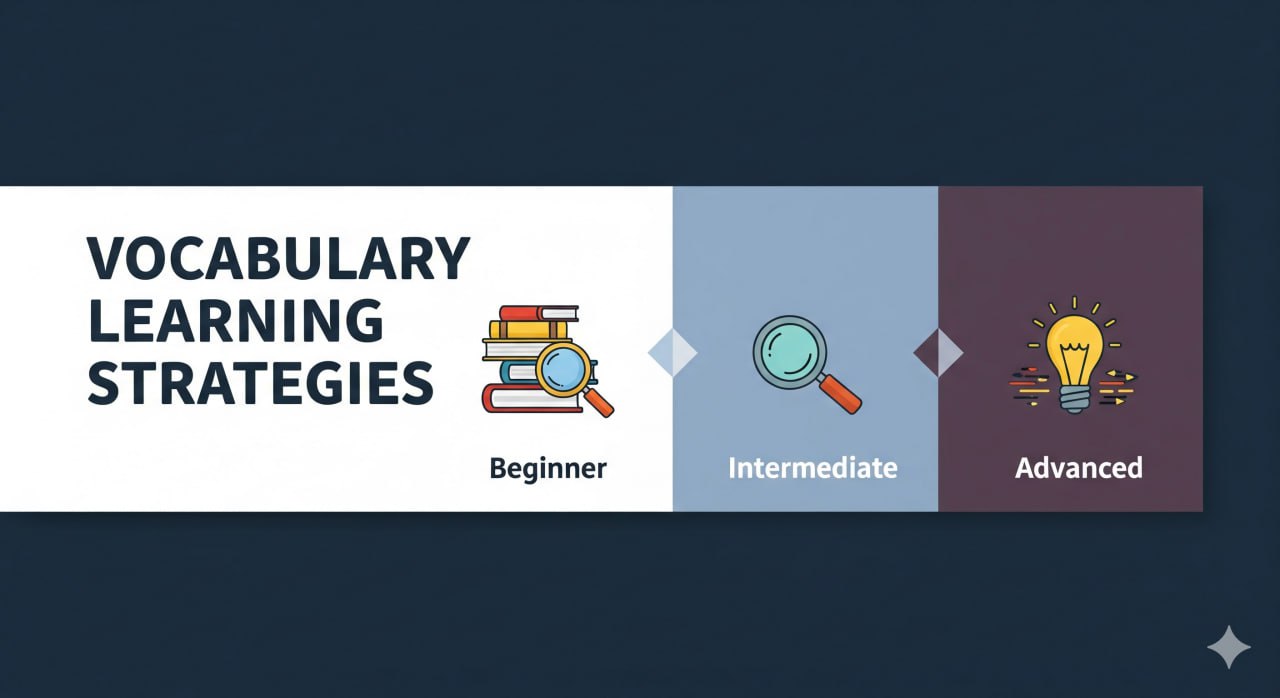A Comprehensive Guide to Vocabulary Learning: Strategies for Every Learner

As an English language educator, you understand that a rich vocabulary is the cornerstone of effective communication. For students at every stage of their journey—from beginner to advanced—mastering new words is a continuous and vital process. However, a single approach cannot serve the diverse needs of all learners. The strategies that propel a beginner forward may not challenge an intermediate student, while an advanced learner requires a nuanced methodology to achieve fluency and precision.
This article presents a comprehensive and tiered guide to the most effective vocabulary learning strategies, meticulously tailored to the specific needs of students at the beginner, intermediate, and advanced levels.
Level I: The Beginner’s Blueprint (A1-A2)
At this foundational stage, the primary objective is to acquire a core vocabulary of high-frequency words crucial for basic communication. These strategies focus on simplicity, retention, and engagement to build a solid base and prevent frustration.
- Thematic Word Lists with Visual Reinforcement Rather than memorizing isolated words, group them by theme. Topics such as “family,” “food,” and “daily routines” provide a logical framework. Pairing these words with clear, compelling images creates a powerful visual-to-word connection that enhances recall.
Application: Develop and distribute simple charts featuring an image, the English word, and its translation. Consistent, daily review is key to embedding these fundamental words in a student’s long-term memory. - The Power of Flashcards Flashcards, whether physical or digital, remain a highly effective tool due to their use of spaced repetition. This scientifically-backed method optimizes memory by reintroducing information at increasingly longer intervals.
Application: On one side, write the English word. On the reverse, include a simple definition, a translation in the student’s native language, and a practical example sentence. Regular practice with a dedicated “difficult words” pile ensures focused attention on challenging vocabulary. - Prioritizing High-Frequency Vocabulary Not all words carry equal weight. Direct students to focus on the most common 1,000 to 2,000 words in the English language. This strategic focus enables them to understand and participate in a significant portion of everyday conversations.
Application: Utilize established resources like the Oxford 3000 or the Cambridge English Corpus to curate a list of these essential words, ensuring learners build a practical and immediately useful lexicon.
Level II: Expanding the Intermediate Lexicon (B1-B2)
With a foundational vocabulary in place, the intermediate learner’s focus shifts from basic memorization to deepening their understanding of how words function within context.
- Contextual Learning from Authentic Materials Encourage students to move beyond isolated lists and engage with authentic English materials, such as news articles, podcasts, or television series. This approach provides a natural environment for encountering and learning new vocabulary.
Application: When a new word is encountered, guide the student to first infer its meaning from the surrounding context. Afterward, they should look up the word and transcribe the entire sentence where it appeared. This practice illuminates the word’s proper usage and nuance. - Understanding Word Families and Collocations Effective communication relies on more than single words; it requires an understanding of how they relate to one another. Introduce the concept of word families (decide, decision, decisive) and collocations—words that are frequently used together (make a decision, take a break, heavy rain).
Application: Challenge students to identify and record common pairings for new words. For instance, after learning the verb take, they should seek out several common nouns that it modifies. - The Personalized Vocabulary Notebook A dedicated notebook is an invaluable active learning tool that allows students to organize their vocabulary in a personalized, meaningful way.
Application: For each new entry, students should record the word, its phonetic pronunciation, part of speech, a simple English definition, and, most importantly, a personal and original example sentence. This process ensures a deeper cognitive engagement with each new word.
Level III: Advanced Mastery and Nuance (C1-C2)
At the advanced level, students possess a substantial vocabulary. The goal is to refine their understanding of idiomatic expressions, phrasal verbs, and the subtle distinctions between synonyms, moving toward a native-like proficiency.
- Thematic Study of Phrasal Verbs and Idioms The non-literal nature of phrasal verbs and idioms can be a challenge. Grouping them by theme, such as idioms related to business or phrasal verbs for social interaction, makes them more manageable.
Application: Encourage the use of flashcards that feature a contextual image instead of a literal one. For example, a picture of a crowded party would be more effective for “to hang out” than an image of someone literally hanging. - Active Production in Speaking and Writing True mastery is demonstrated through active use. Students at this level must be pushed to incorporate new vocabulary into their daily conversation and writing.
Application: Assign regular journal writing with the mandate to use a set number of new words or idioms in each entry. Provide consistent, detailed feedback on their usage to ensure accuracy and confidence. - Reading and Analyzing Complex Texts Advanced learners should engage with sophisticated materials, including academic journals, literary fiction, and complex opinion essays. This exposure cultivates an appreciation for the subtleties of the language.
Application: Guide students to read with a critical eye, asking questions beyond simple comprehension. Encourage them to analyze an author’s word choice: “Why did the author choose saunter instead of walk? What specific feeling does that choice evoke?” This practice refines their understanding of linguistic nuance and prepares them to use the language with a high degree of precision and style.

